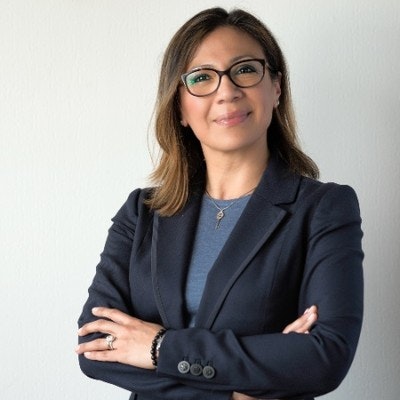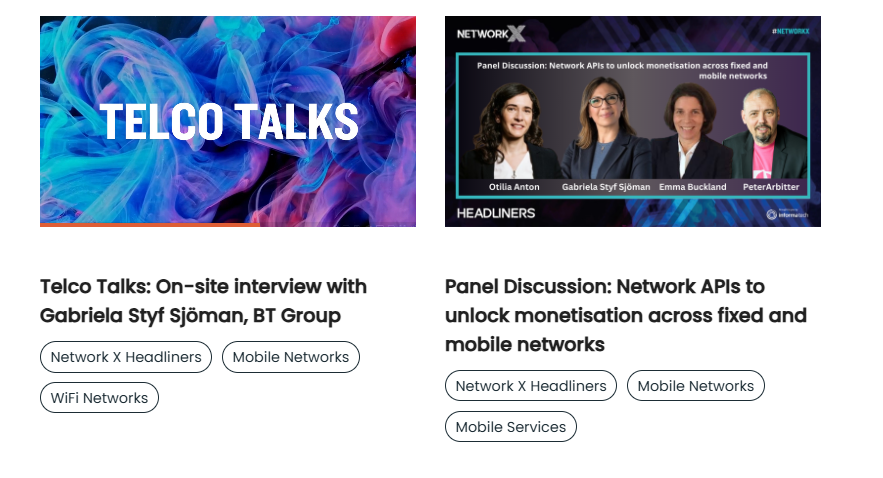Reimagining Connectivity: Gabriela’s Vision
In Telco Talks, we interviewed Gabriela, a seasoned Network X veteran and renowned speaker, to explore her visionary insights on network evolution, AI-driven innovation, and sustainable connectivity solutions shaping the future of telecommunications.
Gabriela Styf Sjöman
Managing Director, Research and Networks Strategy
BT Group

"Networks must evolve—programmable, open, cloudified—to unlock tailored solutions and sustainable growth."
Q: Your career spans leadership roles at Nokia as Chief Strategy Officer, Telia Company as Deputy COO, and now BT Group. How have these diverse experiences shaped your approach to network strategy and research?
My international experience across technology and telecoms has given me a deep understanding of the transformation of digital connectivity. These experiences have shaped my understanding of the forces driving network evolution and help me to build a forward-focussed strategy that reflects customer, industry and societal needs.
We’re at a pivotal point in the evolution of the telco industry. We’re shifting from a world where the technology that we innovated delivered the outcomes - such as connectivity for the masses - to one where technology innovation enables tailored, use-case-specific solutions.
Telcos need to deliver resilient, high-performing connectivity that supports cutting-edge technology and rising data demands—while keeping customer experience front and centre. But there’s also a real opportunity for telcos like BT to go beyond our core connectivity offering, to deliver over the top services to our customers.
To achieve this – networks need to evolve – they need to become fully programmable. Networks need to move from being built as monolithic stacks to becoming open, delayered, cloudified, automated and programable. This will allow telcos to go beyond connectivity, offering value-added services that help customers unlock new efficiencies and growth.
Q: As Managing Director of Research and Network Strategy at BT Group, what aspects of overseeing network modelling, standards, and strategic programs do you find most rewarding in today's rapidly evolving telecommunications landscape?
I’m extremely proud to work for BT—a company that’s driven progress for over 180 years through pioneering innovation and engineering. BT’s ambition is to be the UK’s most trusted digital connector, and I lead our network strategy, R&D, standards engagement, IP, and university partnerships to help realise that vision.
These areas are deeply interconnected, working together to build secure, intelligent networks that empower customers and support the UK’s digital future. BT is a leading voice in global standards bodies, shaping the evolution of fixed and mobile networks. We hold over 5,400 patents worldwide, and for three consecutive years, we’ve ranked #1 in R&D investment across the UK’s telecoms, media, and tech sector.
One of our most exciting research areas is quantum technology—a strategic imperative that will transform industries and national security. We’re securing our networks with quantum-safe cryptography, including PQC and QKD, and we’ve built the world’s first commercial trial of a quantum-secure metro network in London. Now, we’re exploring entanglement-based QKD and preparing for a future quantum internet.
And we’re preparing our infrastructure for a future quantum internet—connecting quantum devices and computers to unleash their full potential.
Beyond networks, we’re innovating in quantum sensing, with IP breakthroughs and successful trials of a quantum radio receiver—an invention that could redefine how signals are detected.
Industry Insights
Q: Having worked across 12 countries on three continents throughout your career, what global telecommunications trends do you see emerging that will have the most significant impact on network strategy in the next 3-5 years?
Artificial Intelligence is one of the most transformative technologies of our time - reshaping industries, unlocking efficiencies, and solving problems once thought too complex. For BT, AI is far more than a trend; it’s a strategic enabler at the heart of how we build and operate our networks.
Our first priority is clear: using AI to automate and optimise network performance. This isn’t new territory - BT has invested in AI for years and holds more AI-related patents than any other network operator in EMEA. Today, AI powers our network planning, monitoring, and optimisation—streamlining operations, reducing environmental impact, and delivering resilient, high-performance services.
AI is also central to our security and operations strategy. Through AI-driven anomaly detection, we’re proactively identifying faults and maintaining a customer-centric approach. Over time, this will evolve into self-healing networks - where AI not only detects issues but resolves them autonomously.
The second frontier is building networks that can support AI technologies at scale. We’re exploring how to future-proof our infrastructure for AI workloads—from edge computing to distributed intelligence. This is about more than capacity—it’s about agility, responsiveness, and trust. What we do now will shape the roadmap for AI-native infrastructure and define the future of digital connectivity.
Q: How is BT balancing the need for continued network innovation with the increasing focus on sustainability and energy efficiency in telecommunications infrastructure?
BT Group has been a leader on climate action for over 30 years. We’ve been tracking our carbon reductions since 1992 and were one of the first companies in the world to set a science-based target in 2008. Today, we’re accelerating efforts to decarbonise our networks, buildings, and fleet, while building toward a fully circular business by 2030 and a circular tech ecosystem by 2040.
For us, network innovation and energy efficiency are inseparable. Smarter networks are greener networks. If we look at AI, by embedding it into our operations, we’re not only driving automation and optimisation, but also unlocking meaningful gains in energy efficiency.
A standout example is our cell sleep technology, now deployed across EE mobile sites nationwide. Using machine learning, it predicts low-demand periods and powers down specific carriers when capacity isn’t needed. This dynamic alignment of energy use with real-time demand is delivering substantial reductions in power consumption - proving that intelligent infrastructure can directly advance our sustainability goals.
As we continue to innovate, we’re committed to ensuring that every step forward in performance is also a step toward a more sustainable future.
Q: With your extensive experience in both fixed and mobile communications, how do you see the relationship between these technologies evolving as we move toward more integrated connectivity solutions?
Our long-term ambition is to bring together mobile, fixed, public Wi-Fi, and non-terrestrial networks to deliver a seamless, fully converged connectivity experience - one that adapts effortlessly to our customers’ lives, wherever they are and whatever they’re doing. This vision demands a highly intelligent ‘network of networks’—as versatile as the people and businesses it serves.
We’ve already laid critical foundations. Our mobile and fixed networks now operate on a converged cloud core, providing the flexibility and scalability needed to meet evolving demands. This transformation enabled the launch of WiFi 7 and 5G Standalone last year—cornerstone technologies of our future-ready network.
Wi-Fi 7 delivers faster speeds, reduced interference, and greater capacity for high-bandwidth activities. 5G Standalone, decoupled from 4G and built for AI-driven performance, enhances reliability and unlocks new capabilities for consumers and businesses. 5GSA is now live in over 90 cities, reaching more than 50% of the UK population.
These innovations are just the beginning. We’re expanding capacity in high-density areas through small cell technology and exploring low Earth orbit satellite connectivity for hard-to-reach locations.
Together, these advancements form the backbone of a truly adaptive, intelligent network—built not just for today’s needs, but for tomorrow’s possibilities.
Event Participation
Q: What key insights about network strategy and research are you most looking forward to sharing with the Network X audience this year?
I’m looking forward to sharing the research we have done in BT that focuses on how we need to re-imagine and translate technology evolution to customer demand and value.
Which industry conversations or collaborative opportunities at Network X do you believe will be most valuable for advancing innovation in telecommunications infrastructure?
I welcome more discussions with government and businesses. The most transformative technology advancements will only translate into sustainable economic growth when supported by strong ecosystems and purposeful collaboration.
BONUS CONTENT

